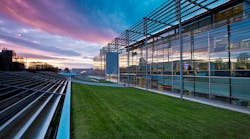Conventional brightness LEDs are widely used as indicator lights in electronic equipment, in simple alphanumeric displays, and as infrared transmitters.
Market research company iSuppli classes high-brightness (HB) LED chips as those with an output exceeding 500 mcd. HB-LEDs accounted for over half of the total LED chip market of $3.8 billion in 2003, while emerging ultra-high brightness devices will make up a sizeable chunk of the $6.8 billion market by 2008.
* See "iSuppli puts total LED market at more than $4.5 billion in 2004."
The HB-LED market has enjoyed phenomenal growth in the last several years. Another market research firm, Strategies Unlimited, which looks at packaged LED numbers rather than at the chip level, says that the HB-LED market grew by 350% between 1995 and 2003, which represents a compound annual growth rate of 47%.
Strategies Unlimited also estimates that the HB-LED market grew by 47% from 2002 to 2003, reaching $2.7 billion. Between 2003 and 2008, the market is predicted to grow at a CAGR of 17%.
* See "HB-LED market showed 47% growth in 2003."
The key applications in 2003 for HB-LEDs, according to Strategies Unlimited, were as follows:
Mobile Appliances: $1.35 billion (50% of total)
Backlights for LCD screens and keypads in mobile phones, camera flashes
Signs & Displays: $486 million (18%)
Single-color moving message panels, full-color video displays
Automotive: $405 million (15%)
Car, truck and bus exterior lighting (stop, turn etc), car interior (instrument panel)
Illumination: $135 million (5%)
Architectural lighting, machine vision, channel letters, decorative and accent lights
Signals: $54 million (2%)
Traffic signals, railroad, aviation
Other: $270 million (10%)
Indicator lamps in commercial, industrial and consumer electronics, entertainment, small indoor displays, miscellaneous




